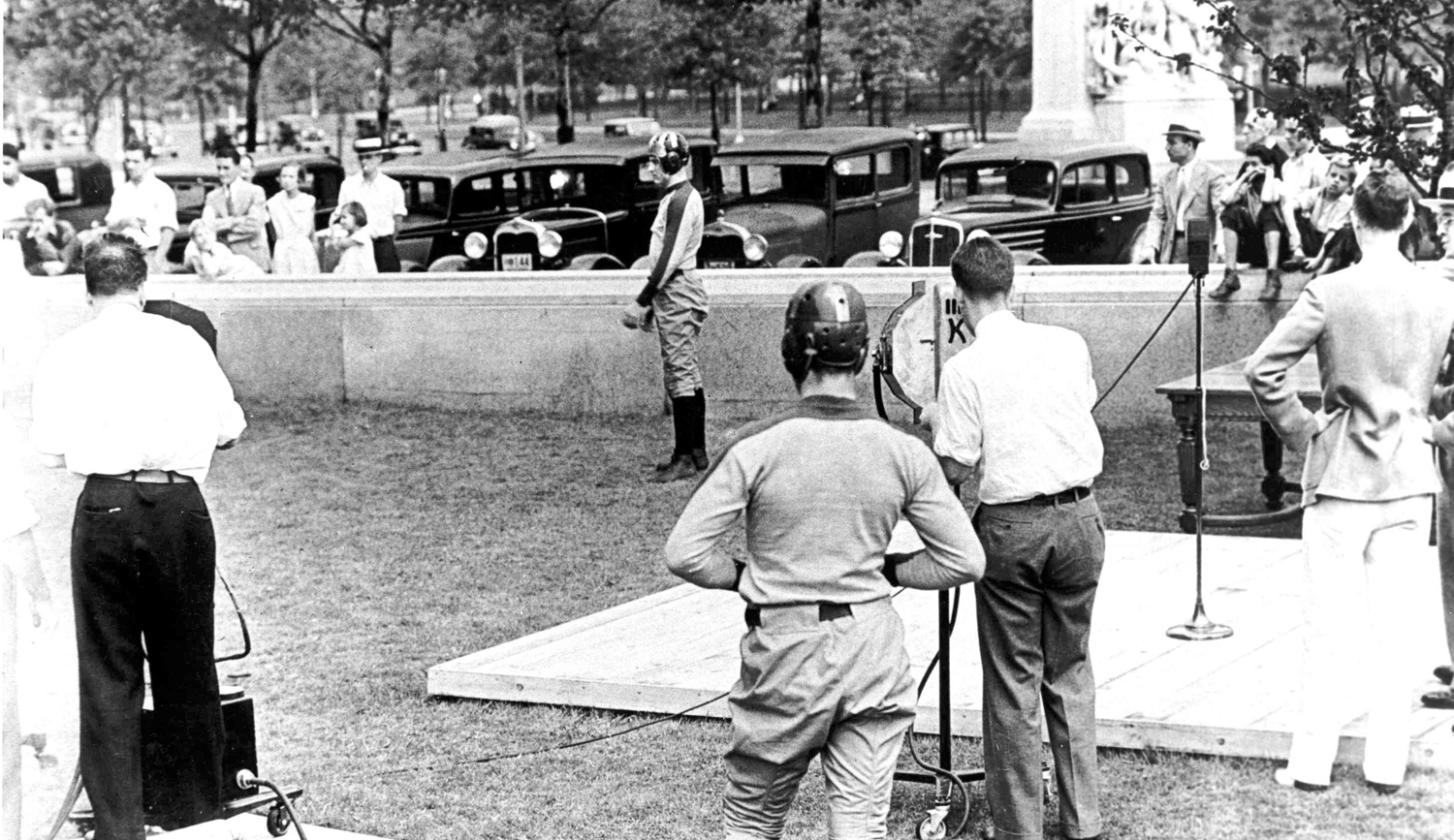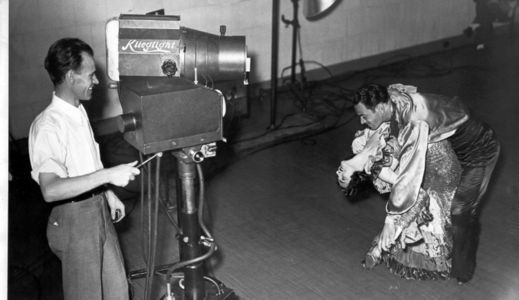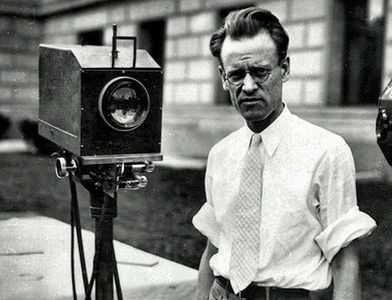1934 Philo T. Farnsworth broadcasts (lost early television demonstrations; 1934)
Philo T. Farnsworth was a television pioneer most known for the development of the all-electronic televisions, and some of its major components, including the video camera tube and the image dissector. By August 1934, Farnsworth was ready to demonstrate his invention to a public exhibition at the Franklin Institute in Philadelphia. Thus, numerous broadcasts were made over 20 days to demonstrate the invention. This also included the first known broadcast of a football game.
Background
Farnsworth's early television demonstrations link back to his early experiments in 1926 and 1927. During this time period, mechanical televisions were being developed, which utilised image scanning devices called rasterizers and Nipkow disks to produce imagery. However, Farnsworth believed that these mechanical systems were limited in their ability to produce quality imagery, and that a replacement all-electronic scanning system would be ideal for better imagery when transmitting to receiving devices.[1]
The first breakthrough came on 7th September, 1927, when Farnsworth's image dissector camera tube was able to produce a straight line to a television receiver at his laboratory in San Francisco.[2] A demonstration to the press on 3rd September, 1928 also proved successful, with the first image produced being a dollar sign, as his backers wanted to know when they could make money from these inventions.[3] By 1929, further progress had been made, as a three and a half-inch image of Farnsworth's wife Pern with her eyes closed was shown on screen, which is known to be the first live images of a human.[4] Thus, on 25th August, 1934, Farnsworth was ready to demonstrate his device to the public at the Franklin Institute in Philadelphia.[5]
The 1934 Broadcasts
Utilising a 220-line system, new broadcast demonstrations were established every 20 minutes, and ran well into the night. Initially, the demonstrations were to be run for about ten days, but such was the popularity of the demonstrations, it was extended for another ten days. For 75 cents, viewers across Philadelphia were able to view all kinds of footage on this new device, including camera footage of the Franklin Institute from its roof to the auditorium, and even see themselves on television when they entered the room. The opening day in particular saw 200 people, including scientists, engineers, media and others who were intrigued by electronic television. Newspaper headings at the time consisted of Farnsworth predicting that television could be in the home within the next decade, and that sets could be sold for around $250,[6] more than $5,100 in today's money.
One of the portable cameras was also taken outside.[7] History was made when footage of a football game was shown on television, recorded on the Franklin Parkway. No details are known regarding who played in the game, but it definitively provided the first images of the sport,[8] ahead of a 1938 Pennsylvania Quakers college football game and a 1939 college football game between Fordham Rams and Waynesburg Yellow Jackets, which are claimed by other sources as being the "first televised football game".[9] Additionally, the camera captured the first televised footage of the Moon.
Following these broadcasts, Farnsworth continued to develop his systems, and in 1939 RCA, Philco and AT&T signed television licence deals with Farnsworth. Thus, his televisions began entering production that same year,[10] and therefore his prediction that televisions would enter the home become realised five years earlier than expected.
Availability
Like all pre-Second World War television, these demonstrations were broadcast live and were not directly recorded as there were no means of achieving this for television prior to the end of the Second World War.[11] Thus, no footage of the Farnsworth demonstrations in 1934 and beforehand survive. Nevertheless, a few photographs are publicly available to help showcase a milestone in television broadcasting.
Images
See Also
Early Sports Television Media
- 1936 Summer Olympics (lost television coverage of Berlin Games; 1936)
- 1938 Pennsylvania Quakers football season (lost early televised college football games; 1938)
- 1960 Daytona Races (lost CBS and NBC televised footage of NASCAR prelude events to Daytona 500; 1960)
- Bill Longson vs Whipper Billy Watson (lost footage of professional wrestling match; 1947)
- Brooklyn Dodgers 2-5 6-1 Cincinnati Reds (lost footage of MLB doubleheader; 1939)
- Columbia Lions 1-2 Princeton Tigers (partially found footage of college baseball game; 1939)
- Indianapolis 500 WFBM-TV Broadcasts (lost racing footage; 1949-1950)
Football Media
- Brooklyn Dodgers 23-14 Philadelphia Eagles (lost footage of NFL game; 1939)
- Fordham Rams 34-7 Waynesburg Yellow Jackets (lost footage of college football game; 1939)
- NFL Blitz (lost arcade prototype; 1997)
- Super Bowl II (partially found live television footage of gridiron football game; 1968)
Early BBC Sports Television
- 1931 Epsom Derby (lost televised footage of horse racing event; 1931)
- 1937 FA Cup Final (partially found footage of football match; 1937)
- 1937 International Imperial Trophy Race (lost footage of motor race; 1937)
- 1937 Wimbledon Championships (partially found footage of tennis tournament; 1937)
- 1938 Ashes Series (partially found footage of international test cricket match; 1938)
- 1938 FA Cup Final (partially found footage of football match; 1938)
- 1939 FA Cup Final (partially found footage of football match; 1939)
- 1947 FA Cup Final (partially found footage of football match; 1947)
- 1953 British Grand Prix (partially found footage of Formula One race; 1953)
- 1955 Scottish Cup Final (partially found footage of football match; 1955)
- Archery (lost early televised toxophily; 1937-1938)
- Arsenal 7-1 Hibernian (lost footage of charity football match; 1952)
- Arsenal vs Arsenal Reserves (lost footage of early BBC televised football match; 1937)
- Barnet 3-2 Wealdstone (lost footage of Athenian League football match; 1946)
- The Boat Race 1938 (partially found footage of rowing race; 1938)
- Catch-As-Catch-Can Wrestling (lost early BBC televised professional wrestling matches; 1938-1939; 1946-1947)
- Charlton Athletic 1-0 Blackburn Rovers (lost footage of FA Cup match; 1947)
- Darts and Shove Ha'penny (lost early BBC televised darts matches; 1936-1939)
- England 0-1 Scotland (partially found international football match; 1938)
- England 1-1 Scotland (partially found footage of international football match; 1947)
- England 16-21 Scotland (partially found footage of rugby match; 1938)
- England 3-0 France (partially found footage of international football match; 1947)
- England 3-0 Rest of Europe (partially found footage of international football match; 1938)
- Falkirk 3-2 Newcastle United (lost footage of football match; 1953)
- Horace Lindrum vs Willie Smith (lost footage of televised snooker; 1937)
- Scottish Universities 1-1 English Universities (lost footage of international football match; 1952)
- Woods and Jack (lost early televised lawn bowls; 1937; 1946)
References
- ↑ The Boy Who Invented Television detailing how Farnsworth saw limitations in mechanical television and set out to establish an all-electronic television. Retrieved 3 Oct '21
- ↑ Infostory discussing Farnsworth's successful 1927 experiment. Retrieved 3 Oct '21
- ↑ The Last Lone Inventor: A Tale of Genius, Deceit & the Birth of Television detailing Farnsworth's dollar sign press demonstration. Retrieved 3 Oct '21
- ↑ Los Angeles Times crediting Pern Farnsworth as being the first human on television in the form of a three and a half-inch image. Retrieved 3 Oct '21
- ↑ The History of Television, 1880 to 1941 providing a date on when the demonstrations first occurred on. Retrieved 3 Oct '21
- ↑ Sports and Their Fans: The History, Economics and Culture of the Relationship Between Spectator and Sport detailing the demonstrations, including noting a broadcast of the Moon and the extension of the broadcasts beyond 10 days. Retrieved 3 Oct '21
- ↑ Philo T. Farnsworth: The Father of Television providing photos of the demonstrations, including Farnsworth and Mable Bernstein inspecting one of the portable television cameras. Retrieved 3 Oct '21
- ↑ The Franklin Institute crediting the demonstrations for providing the first televised images of football. Retrieved 3 Oct '21
- ↑ Fordham Sports noting the disputes being what counts as the "first televised football game". Retrieved 3 Oct '21
- ↑ Zworykin v. Farnsworth Part II: TV's Founding Fathers Finally Meet - in The Lab detailing Farnsworth's deals that led to television being produced in 1939. Retrieved 3 Oct '21
- ↑ Web Archive article discussing how most pre-Second World War television is missing due to no means of directly recording television. Retrieved 3 Oct '21



